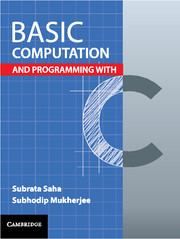Refine search
Actions for selected content:
48558 results in Computer Science

Basic Computation and Programming with C
-
- Published online:
- 17 July 2025
- Print publication:
- 24 May 2016
-
- Textbook
- Export citation
The effects of generative AI model type and visual stimuli type on design creativity
-
- Article
-
- You have access
- Open access
- HTML
- Export citation
Managing technical risks caused by indirect interactions: insights from tracking the use of risk assessment tools
-
- Journal:
- Design Science / Volume 11 / 2025
- Published online by Cambridge University Press:
- 17 July 2025, e28
-
- Article
-
- You have access
- Open access
- HTML
- Export citation
Tracing institutional change in the officer corps using textual data from a military school: promise, pitfalls, and ethical considerations
-
- Journal:
- Data & Policy / Volume 7 / 2025
- Published online by Cambridge University Press:
- 16 July 2025, e50
-
- Article
-
- You have access
- Open access
- HTML
- Export citation
Development of a comprehensive bilateral trade-flow dataset of the environmental pressures of global food production
-
- Journal:
- Environmental Data Science / Volume 4 / 2025
- Published online by Cambridge University Press:
- 16 July 2025, e34
-
- Article
-
- You have access
- Open access
- HTML
- Export citation
Open energy services: forecasting and optimization as a service for energy management applications at scale
- Part of
-
- Journal:
- Data-Centric Engineering / Volume 6 / 2025
- Published online by Cambridge University Press:
- 14 July 2025, e35
-
- Article
-
- You have access
- Open access
- HTML
- Export citation
Revisiting the assumptions of the data revolution as an accelerator of the sustainable development goals
-
- Journal:
- Data & Policy / Volume 7 / 2025
- Published online by Cambridge University Press:
- 14 July 2025, e49
-
- Article
-
- You have access
- Open access
- HTML
- Export citation
Empowering designers to create life cycle informed products: heuristics for extracting insights from LCA reports
- Part of
-
- Journal:
- Design Science / Volume 11 / 2025
- Published online by Cambridge University Press:
- 14 July 2025, e27
-
- Article
-
- You have access
- Open access
- HTML
- Export citation
Data-driven innovation: challenges and insights of engineering design
-
- Journal:
- Design Science / Volume 11 / 2025
- Published online by Cambridge University Press:
- 14 July 2025, e26
-
- Article
-
- You have access
- Open access
- HTML
- Export citation
Dialogue-based computer-assisted language learning systems for second language speaking development: A three-level meta-analysis
-
- Journal:
- ReCALL , First View
- Published online by Cambridge University Press:
- 14 July 2025, pp. 1-17
-
- Article
-
- You have access
- Open access
- HTML
- Export citation
PhD Abstracts
- Part of
-
- Journal:
- Journal of Functional Programming / Volume 35 / 2025
- Published online by Cambridge University Press:
- 14 July 2025, e15
-
- Article
-
- You have access
- Open access
- HTML
- Export citation
Couplings and Poisson approximation for stabilising functionals of determinantal point processes
- Part of
-
- Journal:
- Combinatorics, Probability and Computing / Volume 34 / Issue 5 / September 2025
- Published online by Cambridge University Press:
- 11 July 2025, pp. 635-648
-
- Article
-
- You have access
- Open access
- HTML
- Export citation
Questions in design computing research and ways for exploring them: a systematic review of the DCC conference
-
- Journal:
- Design Science / Volume 11 / 2025
- Published online by Cambridge University Press:
- 10 July 2025, e25
-
- Article
-
- You have access
- Open access
- HTML
- Export citation
Physics-constrained machine learning for reduced composition space chemical kinetics
-
- Journal:
- Data-Centric Engineering / Volume 6 / 2025
- Published online by Cambridge University Press:
- 10 July 2025, e34
-
- Article
-
- You have access
- Open access
- HTML
- Export citation
